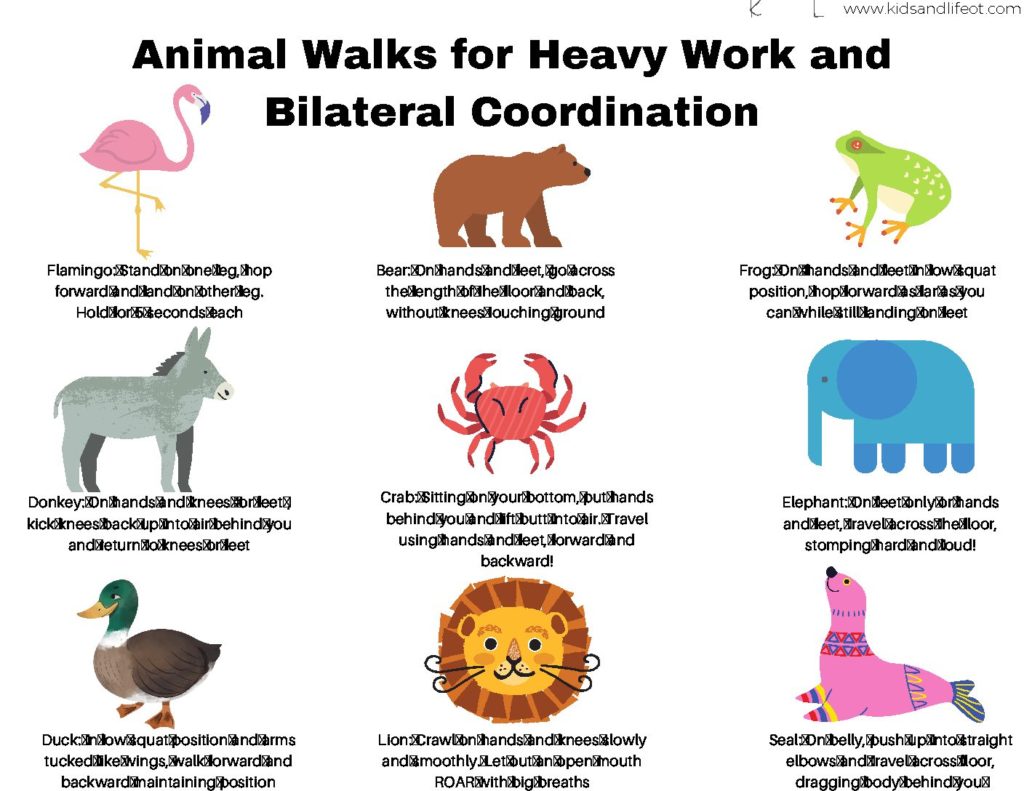What is heavy work and why is it important? For some of you reading this, this post might be filled with new terms that you have never heard of and don’t apply to you. For others, you may read this and immediately have a child in mind.
I’m going to talk a bit about sensory systems and our body’s ability to process sensory information or input. If you’d like a more detailed overview, check out my post on Sensory Processing.
Heavy Work or Proprioceptive Input
Heavy work is a way to describe activities that give us proprioceptive input. Proprioception is our sense that provides body awareness and general regulation. Our proprioceptive sense brings in and organizes input to our muscles and joints in order to understand where our body is in space and contributes to attention and regulation. Here are some examples that we, as adults, receive proprioceptive input throughout the day.
- When we naturally shift our weight, we are changing the compression between body parts, giving brief moments of relief and body awareness.
- When we go for a run, we are getting input to our joints, providing sustained and predictable input that can be regulating.
- When we participate in a strength training workout with weights, we feel good afterward because of our body’s response to proprioceptive input.
- When we get a massage, we are very aware of our body and space and feel regulated afterward.
How do I know if a child needs “heavy work”?
Some kiddos process sensory information without difficulty. Some people need more or less of it to make sense of a situation. Sometimes we see this manifest in various behaviors. Here are some signs that might suggest a kiddo could benefit from additional heavy work:
- seeking it out through rolling around, leaning against others or surfaces, tackling or wrestling with others out of context
- constant moving
- risk taking behaviors (physically- jumping off of high surfaces)
- difficulty attending
What does “heavy work” look like?
In talking about heavy work, we can think of activities that involve us using large muscle groups. These activities encourage us to lift, carry, push, pull, pound. Typically heavy work is an active way to receive proprioceptive input. It also provides an additional movement break because of the active nature of it. If the child in your life needs more passive input to avoid overarousal or overstimulation, check out my post on this (coming soon!).

Try the activities below and note how the child responds afterward as well as during the day in general. Note that you can provide the child with both active and passive activities, depending on how the child reacts and what he needs in the moment. But let’s get on with it already! Here are my favorites.
*This post contains affiliate links and I may receive commission when you click on links and make purchases. However, this does not impact the price you pay!
Top 25 Heavy Work Activities

Pushing
- Gather heavy items and put them into a laundry basket, shopping cart, wagon, or box. Have the child push it across the floor! Place more objects on both ends of the track and have them empty/add objects
- Sit across from each other and interlace fingers and have pushing wars
- Similarly, sit with feet touching and push against a partner’s feet
- Push against the wall (“wall pushes”). Try to move the room and make it bigger!
- Chair pushups. Lift your butt off of the chair for 10 seconds. If she is able, have her dip down and push back up to straight arms
- Do pushups or planks!
- On his stomach on an exercise ball, roll out to walk on hands and walk back. Or, have him roll toward a wall and push off of it to roll back, keeping his feet up.
- Vacuuming, lawn mowing, shoveling (if age appropriate). Incorporate these chores into her day and set them as expectations. It is helpful to get natural sources of input during daily routines.
- Animal walks. Use this visual to pick from!

Pulling
10. Use that same laundry basket, wagon, or box and pull those items with a rope
11. Give each other rides on a blanket on hard floors. Have a sibling or friend sit on a blanket and pull them across the floor
12. Play tug of war! Inside with shorter ropes, outside with a standard rope. Use the dog to play if available!
13. Grab a scooter board or skate board and have the child lay on his stomach. Have him push/pull using his hands or arms on the floor or pull with a rope or hula hoop (excellent strengthening idea as well!)
14. Rock climbing, swimming, biking, rowing, kayaking; all of these activities involve a pulling (and pushing) motion
15. Climbing and crawling over couch cushions and pillows on the floor. To make it harder, hold his hips and pretend he’s crawling through sand or mud or lava!
16. Raking, sweeping, wiping down counters (appropriate for as young as 2 years of age! Although not incredibly efficient or effective at that age…)

Lifting and Carrying*
*Please note: this section suggests using heavy items. If your child has a medical condition, this may be contraindicated and you should check with your healthcare provider. Also, items should be 10-15% of the child’s body weight when engaging in active use, which is not a lot. Don’t feel like you need to overload the child!
17. Fill a little backpack with heavy books. This can be a good tool to use when you’re out and about if your child needs additional input for regulation
18. Help with yard work and transferring mulch, dirt, plants, rocks, use of wheelbarrow
19. Use weighted items such as weighted blankets, medicine balls, or stuffed animals and carry them from room to room, place them within an obstacle course, or put those in the laundry basket I mentioned earlier
20. Have kids help carry groceries in; use half-gallons of milk, laundry detergent, and canvas bags with handles to have them help bring those groceries in from the car (win win!)

Pounding
21. Jumping; hopscotch, mini trampoline, bounce on an exercise or peanut ball, hippity hop, pogo stick, or play “The Floor is Lava” with non-slip surfaces
22. Go hiking, walking, or running
23. Tumbling or gymnastics
24. Stomping; try it to the beat of a drum or song
25. Crash into couch cushions, onto a bed, or obtain a crash pad. (Pro Tip: call your local upholstery store or mattress vendor. Ask if they sell or put aside extra stuffing that would get thrown away. You could put this into a fitted sheet or duvet cover for a DIY crash pad!)
So there you have it. Again, use natural breaks in the child’s day, such as recess and free play, but also implement some of these daily routine tasks into your child’s chore list if needed. Looking for an extracurricular to try but your child needs a little more input? Try some of the ones mentioned here. Then, supplement your child’s needs with bursts of the other activities in the list above.
Here’s a tip: Transitioning back to the task at hand can sometimes be hard after these fun activities. Establish the amount of time, repetitions, or duration that the child will engage in the activity beforehand (when it is used as a sensory break versus free play). Consider setting a timer, completing for a favorite song, or marking off boxes as you go through each repetition. This concrete ending can help a child return back to whatever task is at hand afterward.
Proprioceptive input is so powerful. Please share with me! I want to hear some of your favorite heavy work activities!
Looking for even more ideas? Check out The Out of Sync Child and The Out of Sync Child Has Fun




Wonderful post! We will be linking to this particularly great content on our website. Keep up the great writing. Steffi Ruben Ann-Marie
Great, thanks for sharing this post. Thanks Again. Really Great. Karlie Fabiano Kosiur
I am a Kindergarten gen ed teacher and am looking forward to using this resource with a student in my room. Thanks for making it free!
Yay! Absolutely. Let me know how it goes!
this is brilliant .. thank you so much!!